#classic toons and movies should co-exist
Explore tagged Tumblr posts
Text

"Under the Tropical Islands"
POV: You didn't move much when admiring the coral reefs. A fish slowly approaches you, seemingly want to accompany you too :)
Competition Entry for "What Summer Is To You" in a gaming server.
This is my first time ever drawing ocean themed artwork. The following is how the artwork had been made. If you guys are interested, I can write about the ideas of each finished drawing :)
Q: What Summer Is To You?
Summer is the season filled with the things I want to do. Due to the fast pacing of where I live, there's hardly any time for me to actually do things I want to do.
Growing up, I really love nature, ocean is just one of those things. Recently I've joined a activity with youngsters to learn kayaking, and snorkelling to see some of the adorable fish and beautiful coral reefs. This leaves a deep impression for me because the extreme weather condition hasn't affect the waters from our location.
After that activity, I remember Red's house was by the ocean in the Angry Birds Movie. This gives me a impression that Red loved the peacefulness in urban areas. If he wasn't a clown/cake deliverer, I wonder if he would get a license and went scuba diving instead.
To describe the drawing, Red decided to go scuba diving. Here he realized under the tropical island, the ocean is filled to the brim with coral reefs and different kinds of fish. Since he didn't really move much when admiring the bright colored reefs, a fish gently swam closer to Red with curiosity, seemingly want to accompany him too. :)
#angry birds#artists on tumblr#artwork#drawing#angry birds fanart#digital art#digital illustration#red angry birds#scuba diving#Red is such a lovely character#the movie was awesome but the price was pretty steep#classic toons and movies should co-exist#i love red#angry birds red#.creator draws
12 notes
·
View notes
Text
The Animaniacs Shared Universe (A.K.A The Tooniverse)
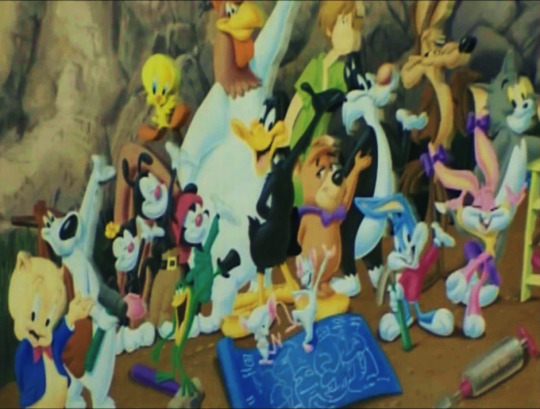
It goes deeper than you think!
(I put way too much thought into this lol)
Tier 1 - Mutually Canon (They definitely share a universe)
I'll be separating each property mentioned into tiers (hey I told you I put too much thought into this). This tier is for properties where characters from Animaniacs have shown up in them as themselves, and vice versa. These have to be more than just references. No parodies, knockoffs, cases where the characters exist but are fictional in universe (as in they're not toon actors, they're fictional cartoon characters with no thoughts of their own), etc. These are part of the ASU, no question.
Tiny Toon Adventures
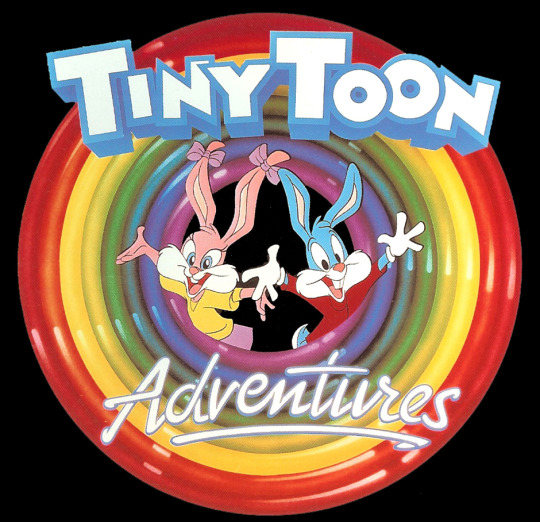
First, there's the fact that Ralph debuted in Tiny Toon Adventures, before he became a recurring character in Animaniacs, although he was unnamed at the time:
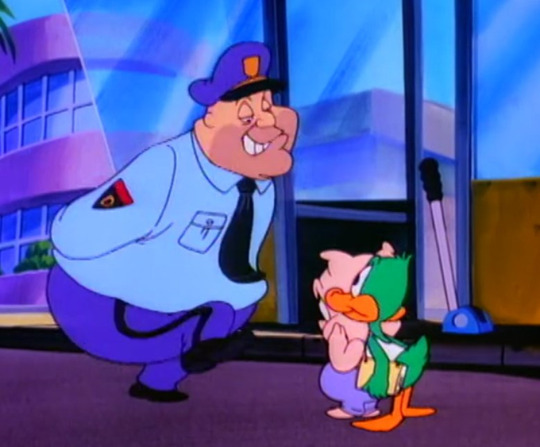
Then, once Animaniacs started, characters from Tiny Toon Adventures would often make cameos, and Animaniacs characters would cameo in Tiny Toons' post-series specials:
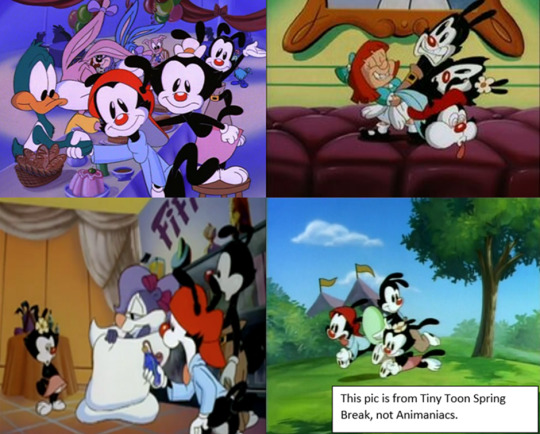
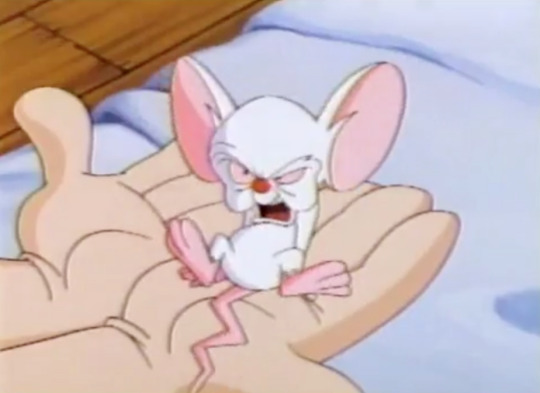
Before I move on to the next property, although most of the properties mentioned in this post don't always adhere to continuity, I still only want to provide evidence from content that at least could be considered canon, so while I feel obliged to acknowledge the existence of "Pinky, Elmyra and the Brain", given that it isn't canon, it's depiction of how these characters share a universe doesn't really matter.
Pinky and the Brain
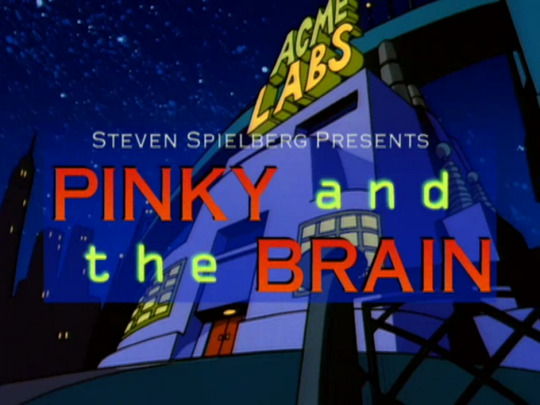
A pretty obvious pick, given that Pinky and the Brain were initially just Animaniacs co-stars before getting their own show:
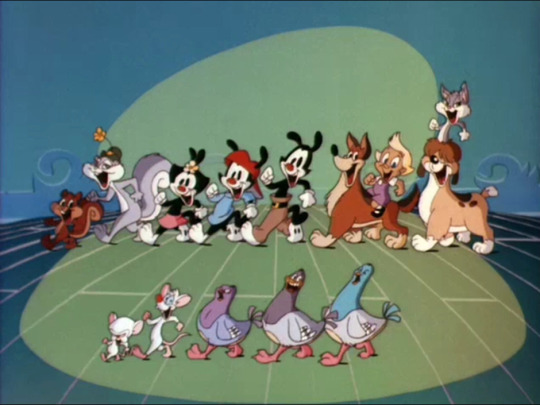
Their spin off series has plenty of references to Pinky and the Brain's adventures in Animaniacs. Also, Phar Fignewton, Billie, and other Animaniacs characters all make appearances (with Billie and the Warners appearing multiple times):
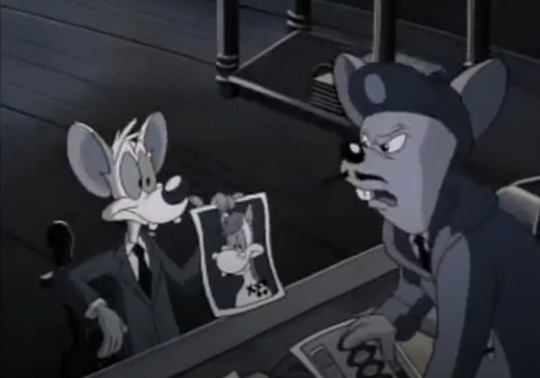
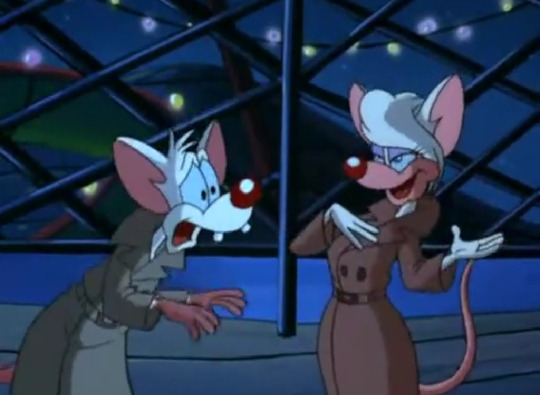
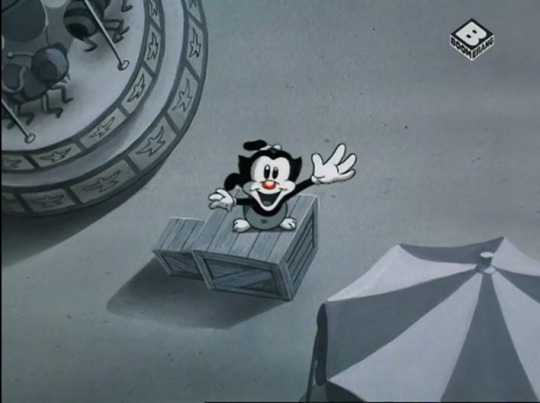
Those in addition to the series finale ("Star Warners"), where the cast of Animaniacs reunite to do a sketch that parodies Star Wars, make it clear that the spin off definitely takes place in the same world as Animaniacs.
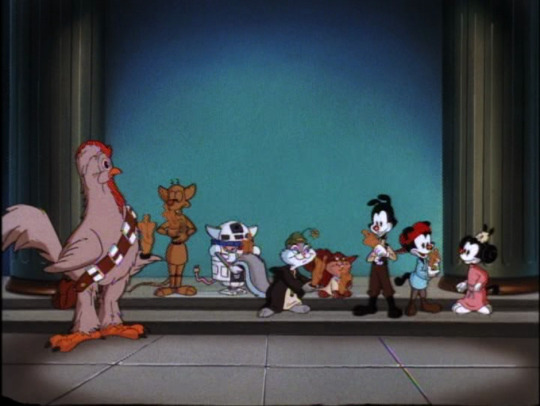
Freakazoid!

This show is more removed from Animaniacs than the previous two properties, but Wakko and Brain show up in Freakzaoid, and Freakazoid shows up in Animaniacs and Pinky and the Brain, so it's in the ASU alright.
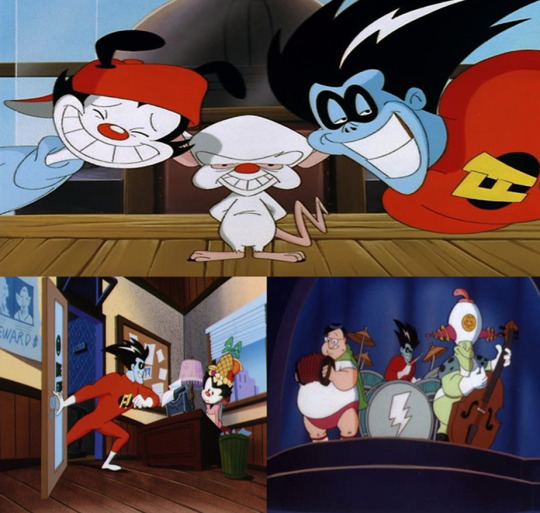
Space Jam/Classic Looney Tunes
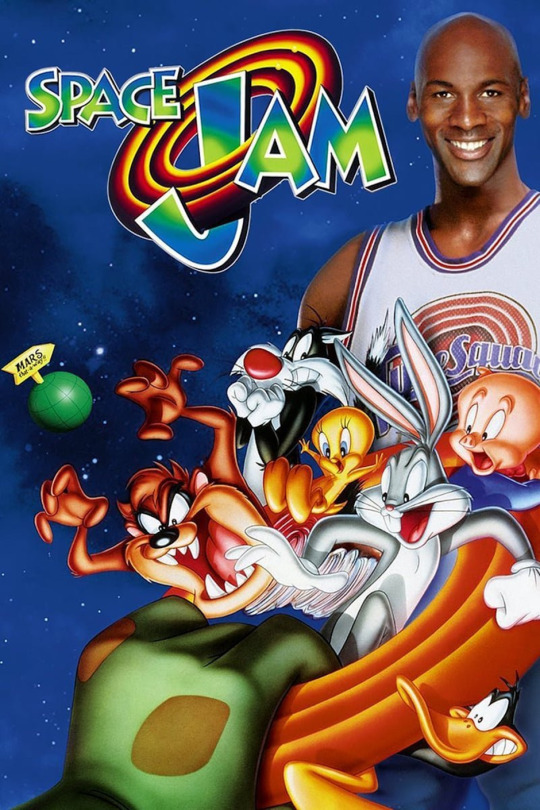
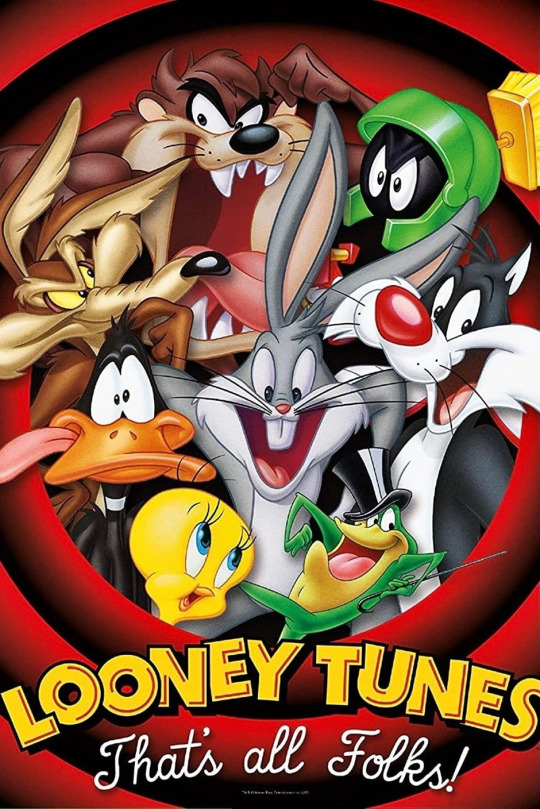
I realise that Looney Tunes in general doesn't really have a "universe", just various iterations/reboots. So the versions of the Looney Tunes I imagine exist in the ASU are the ones in the Space Jam movies/classic shorts (or pretty much any version of them that are toon actors in the modern world).
The Looney Tunes appear or are at least mentioned in Animaniacs multiple times:
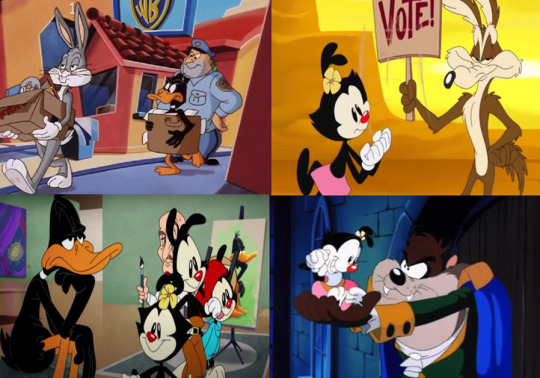
Space Jam is alluded to in the Pinky and the Brain episode "Inherit the Wheeze", and the Warners are in Space Jam: A New Legacy (their water tower is even placed in Looney Tunes World in the movie).
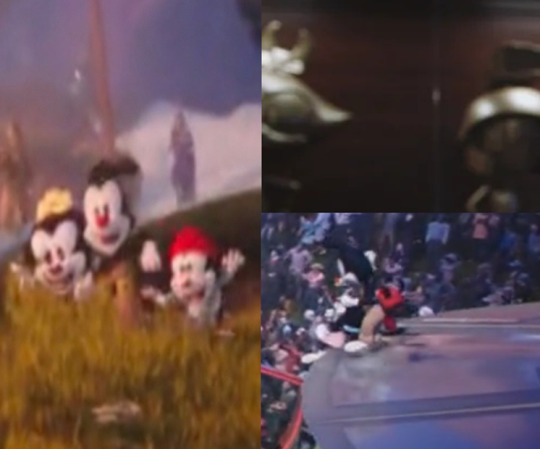
There's also the fact that Tiny Toons is an official Looney Tunes spin off, so presumably if Animaniacs shares a universe with that show the Looney Tunes should therefore exist as toons in the ASU.
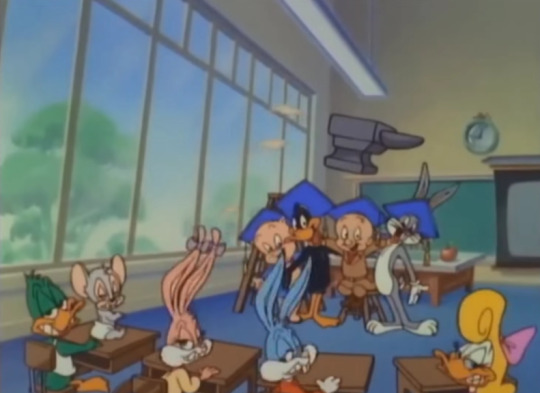
Tier 2 - Implied/Headcanon (They could share a universe)
For cases where Animaniacs or another ASU property implies that they share a universe, but this isn't done the other way round (for example, if a character from the property appeared in Animaniacs, but no characters from Animaniacs appear in their franchise). This can be done via references, cameos, mentions, etc., but they have to come off as more than just references/jokes, they have to imply characters from those properties really do exist. Basically, the Tooniverse may consider them canon, but the feeling isn't mutual (yet, at least).
Mickey Mouse & Friends
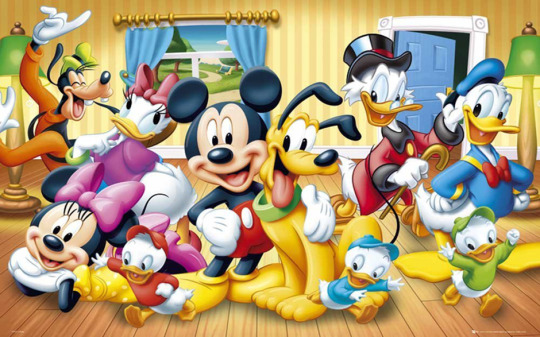
For this franchise, when I say they might "share a universe" it's assuming the context is that Mickey and Friends are also toon actors in the real world, like the Warners, Slappy, Bugs, etc. I'm also including Goof Troop stuff, Donald Duck universe stuff, etc. WB cartoons reference/take shots at Mickey/Disney ALOT, so I'll only talk about a few references that imply that Mickey, Minnie, etc. are real people in Animaniacs.
Slappy mentions attending Daisy Duck’s bar mitzvah in a season 3 segment called "Gimme a Break", so that implies Daisy, and therefore the rest of the gang, really do exist and aren't just fictional characters. She also mentions Huey, Dewey, Louie in the same episode. She mentions these characters while delirious, but one of her gimmicks is being reminded of younger versions of other cartoon stars she's met, so who's to say she hasn't actually met them?
Dot says "Why don't you go bug the kids on Goof Troop?" to a nanny in another season 3 segment called "The Sound of Warners". Again it's just a mention (and a sarcastic one at that), but it does imply that they are real people in their world.
DuckTales has been mentioned a few times; by Pinky in "Opportunity Knox" ("Egad, this is better than a DuckTales episode.") and Yakko mentions the DuckTales reboot in "Suspended Animation - Part 2".
These references alone don't imply Scrooge, the triplets, etc. are real, but alongside the previous references, it does seem to imply that the cast of DuckTales are animated actors in this world too (Animaniacs, the show, exists in-universe too yet the Warners are real people).
All these and more just seem to repeatedly hint that Mickey and his pals are toons in Animaniacs just like the Warners, but since they're from another studio we can't see them onscreen.
This is supported by the possible presence of…
Roger Rabbit
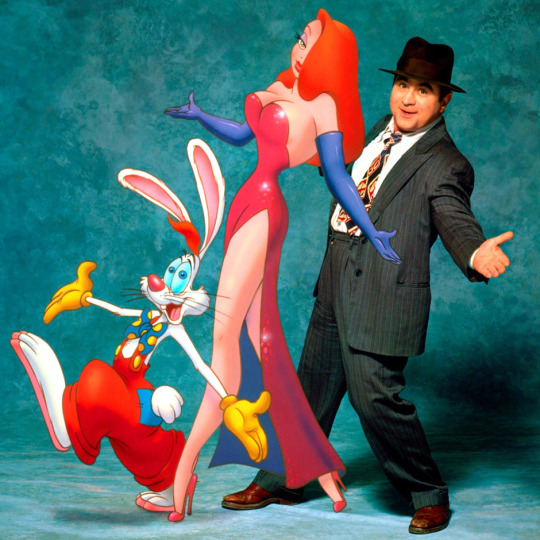
Ralph greets Roger as he enters the lot in the limo (presumably with Jessica) in Tiny Toon Adventures, and although we don't see Roger's face and he's wearing grey gloves rather than yellow ones, Ralph explicitly refers to him as "Roger":
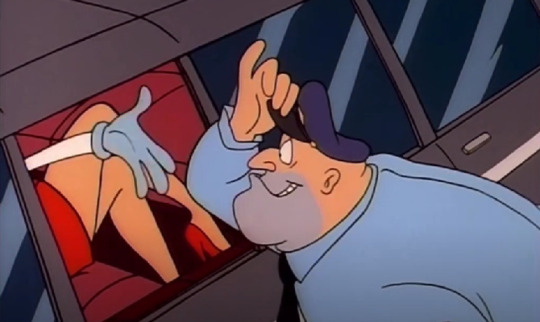
He shows up again later:

OK I admit this one's kind of a cheat because this guy could count as a knockoff (different clothes), but think about it, if he is just supposed to be a knockoff, why hide his face? Why make sure we never see him up close? He's one of the only supposed knockoff characters they do this with. It just implies that this is actually supposed to be Roger, but for the sake of copyright they keep his face away from the camera, since Roger Rabbit is considered a Disney property.
Mickey, Minnie and more appear in WFRR, which goes perfectly with the implication that they are toon actors in Animaniacs. It’s also one of the only properties where both Bugs and Mickey exist (or in Animaniacs' case, Mickey is implied to exist) in the real world as themselves and not parodies or fictional characters. I'm just saying, Animaniacs and Who Framed Roger Rabbit being taking place in the same world would make sense, considering they are both about toons in the real world.
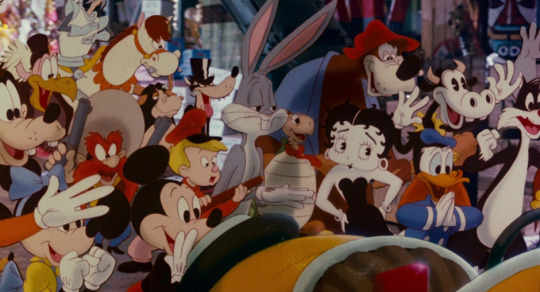
Plus, Steven Spielberg directed Who Framed Roger Rabbit and even voices the "knockoff". I think it's only fitting the movie that got him invested in directing animation shares a universe with the rest of his animated work.
Tier 3 - Reaches/Outside References (It's possible they share a universe, but unlikely)
For cases where a property implies/shows that Animaniacs/ASU characters exist in their world, but this has not happened the other way round. This tier is also for cases where the property has no canon and hence can't share a universe.
Histeria!
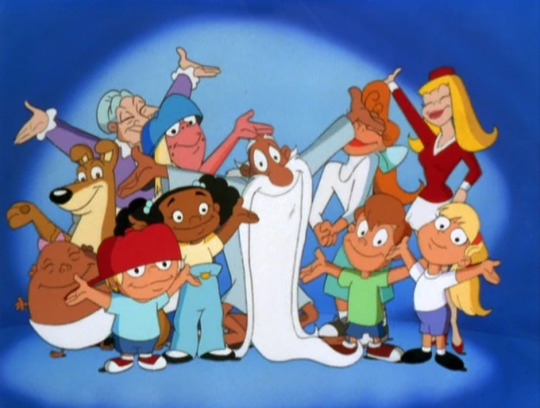
Some of the character models that were used in Histeria came from Animaniacs (like ones for caricatures of historical figures such as Michelangelo and Ludwig von Beethoven), and some Animaniacs characters are mentioned/seen in Histeria!:
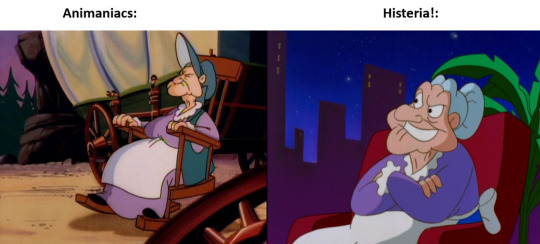

So why isn't it in Tier 1?
Two reasons. First, in regards to the character models, this seems to be a case where they just reused background character designs rather than intentionally putting an established character in a different show. For example, the World's Oldest Woman was not given a name until Histeria! and was slightly redesigned, and Ludwig von Beethoven has a different voice in Histeria!, so they're not really official appearances of those characters as their Histeria! selves. Yes that's a similar situation to Ralph, but the difference is that the background characters have completely different roles in Histeria! whereas Ralph is the WB security guard in both Tiny Toons and Animaniacs and looks exactly the same (Frank Welker even voices him in both). In the case of the historical figures, two properties depicting the same historical figure does not mean that they share a universe.
As for the Animaniacs references, Histeria has no canon. It's not like Looney Tunes and Space Jam where there's at least a duology of films where one continues the story of the other. There are recurring characters and gags but each episode is completely standalone (different settings, time periods, etc.), unlike most of the other properties which are episodic, but do have continuity (Miss Flamiel is hired in her debut episode and continues to be the Warner's teacher in later episodes, Snowball buys Microsponge in season 1 of PATB and still owns it in season 4, etc.) Histeria! exists in it's own little reality-warping world. Therefore any references to Animaniacs are just that: references.
Teen Titans Go!
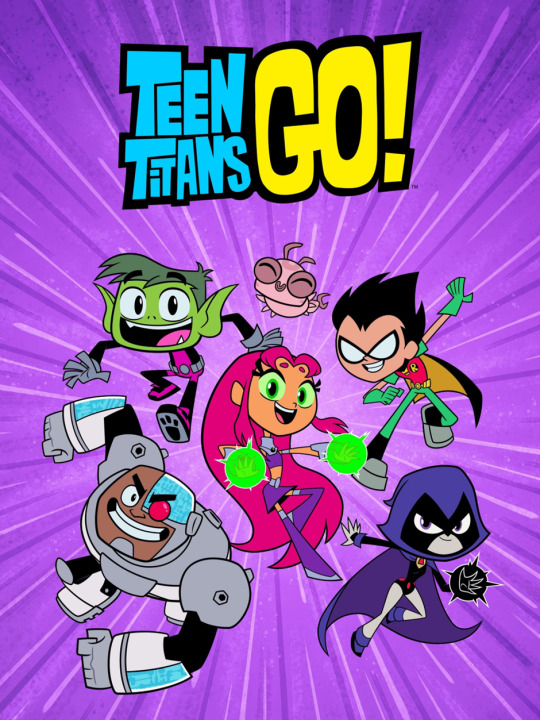
Yes, really.
Starfire mentions that the WB water tower is where "the Animaniacs" live in "Teen Titans GO! To the Movies".
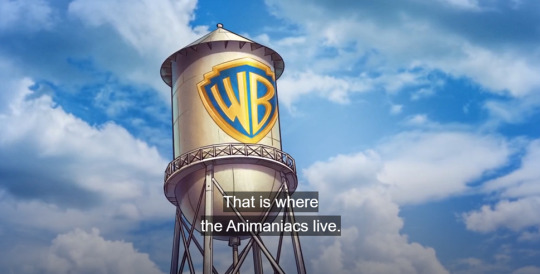
(Yes they make the mistake of calling the Warners "the Animaniacs" when that name is meant to refer to the entire recurring cast of the show, but to be fair official Animaniacs media has made this same mistake so whatever.)
And before anyone thinks "Well she's an alien who probably doesn't understand that cartoon characters aren't real", TTG is yet another show where toons are actors in the real world. This is confirmed in multiple episodes, such as their Warner Bros. 100th Anniversary special:
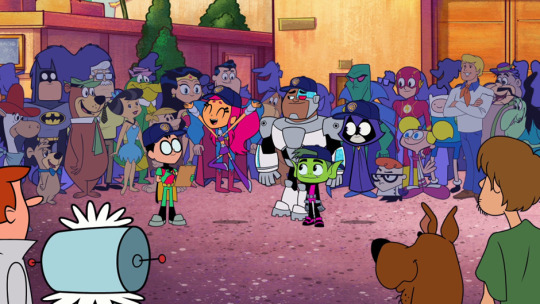
So Starfire knew exactly what she was talking about. The thing is, the Warners themselves don't appear in any episodes of the show, neither inside or outside the water tower. However, the Animaniacs cast may still exist as toon actors in their world. This is implied by:

TTG'S ACTUAL CROSSSOVER WITH FREAKZOID. Granted, he is sort of treated as a fictional character, but in a meta way that would fit right at home in an episode of Freakazoid. The toon actor reasoning can still apply. The point is he's interacting with the real world and doesn't only exist within a TV screen. However, until TTG itself is referenced in some way in either official Animaniacs media or some other ASU property, these are just references.
.
.
.
I realise most of these were probably just seen as fun cameos and/or references and nothing more, but the idea of the Warners and Bugs Bunny canonically being co-workers who have known each other for years, or something like Dip actually existing in their world, etc. just feels right. Helps the world seem...larger, and more developed! (Goodnight Everybody!)
Ahem. Anyway, this was post fun to think about, and only slightly less fun to make (f#@% the 30 image per post limit).
#animaniacs#pinky and the brain#looney tunes#mickey mouse#dc#patb#tiny toon adventures#freakazoid#space jam#space jam a new legacy#mickey mouse and friends#ducktales#goof troop#who framed roger rabbit#roger rabbit#histeria!#teen titans#teen titans go#ttg#shared universe#OK so apparently Brain makes a voice cameo in Road Rovers but I only found that out when this post was basically done#and again I hit the image limit so uh...#that one's just a reference#and if that bothers you then fine pretend it's in tier 3 k bye
138 notes
·
View notes
Photo
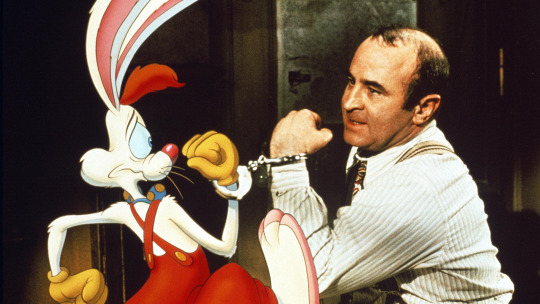
Blurring the Line.
As a new Space Jam film beams down to Earth, Kambole Campbell argues that a commitment to silliness and a sincere love for the medium is what it takes to make a great live-action/animation hybrid.
The live-action and animation hybrid movie is something of a dicey prospect. It’s tricky to create believable interaction between what’s real and what’s drawn, puppeteered or rendered—and blending the live and the animated has so far resulted in wild swings in quality. It is a highly specific and technically demanding niche, one with only a select few major hits, though plenty of cult oddities. So what makes a good live-action/animation hybrid?
To borrow words from Hayao Miyazaki, “live action is becoming part of that whole soup called animation”. Characters distinct from the humans they interact with, but rendered as though they were real creatures (or ghosts), are everywhere lately; in Paddington, in Scooby Doo, in David Lowery’s (wonderful) update of Pete’s Dragon.
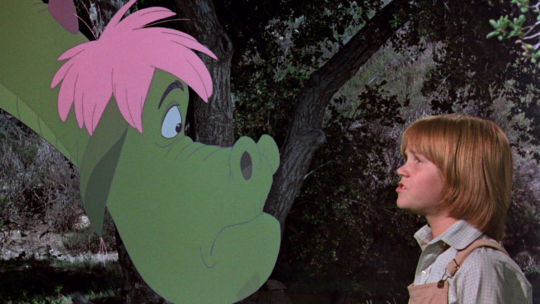
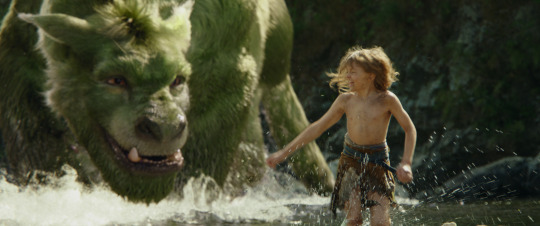
The original ‘Pete’s Dragon’ (1977) alongside the 2016 remake.
Lowery’s dragon is realized with highly realistic lighting and visual-effects work. By comparison, the cartoon-like characters in the 1977 Pete’s Dragon—along with other films listed in Louise’s handy compendium of Disney’s live-action animation—are far more exaggerated. That said, there’s still the occasional holdout for the classical version of these crossovers: this year’s Tom and Jerry replicating the look of 2D through 3D/CGI animation, specifically harkens back to the shorts of the 1940s and ’50s.
One type of live-action/animation hybrid focuses on seamless immersion, the other is interested in exploring the seams themselves. Elf (2003) uses the aberration of stop-motion animals to represent the eponymous character as a fish out of water. Ninjababy, a Letterboxd favorite from this year’s SXSW Festival, employs an animated doodle as a representation of the protagonist’s state of mind while she processes her unplanned pregnancy.
Meanwhile, every Muppets film ever literally tears at the seams until we’re in stitches, but, for the sake of simplicity, puppets are not invited to this particular party. What we are concerned with here is the overlap between hand-drawn animation and live-action scenes (with honorable mentions of equally valid stop-motion work), and the ways in which these hybrids have moved from whimsical confections to nod-and-wink blockbusters across a century of cinema.
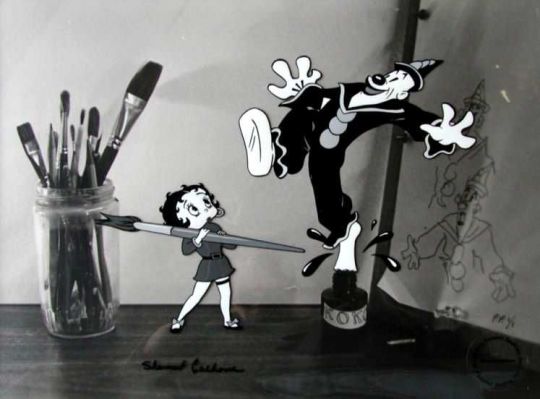
Betty Boop and Koko the clown in a 1938 instalment of the Fleischer brothers’ ‘Out of the Inkwell’ series.
Early crossovers often involve animators playing with their characters, in scenarios such as the inventive Out of the Inkwell series of shorts from Rotoscope inventor Max Fleischer and his director brother Dave. Things get even more interactive mid-century, when Gene Kelly holds hands with Jerry Mouse in Anchors Aweigh.
The 1960s and ’70s deliver ever more delightful family fare involving human actors entering cartoon worlds, notably in the Robert Stevenson-directed Mary Poppins and Bedknobs and Broomsticks, and Chuck Jones’ puntastic The Phantom Tollbooth.

Jerry and Gene dance off their worries in ‘Anchors Aweigh’ (1945).
Mary Poppins is one of the highest-rated live-action/animation hybrids on Letterboxd for good reason. Its sense of control in how it engages with its animated creations makes it—still!—an incredibly engaging watch. It is simply far less evil than the singin’, dancin’ glorification of slavery in Disney’s Song of the South (1946), and far more engaging than Victory Through Air Power (1943), a war-propaganda film about the benefits of long-range bombing in the fight against Hitler. The studio’s The Reluctant Dragon (1941) also serves a propagandistic function, as a behind-the-scenes studio tour made when the studio’s animators were striking.
By comparison, Mary Poppins’ excursions into the painted world—replicated in Rob Marshall’s belated, underrated 2018 sequel, Mary Poppins Returns—are full of magical whimsicality. “Films have added the gimmick of making animation and live characters interact countless times, but paradoxically none as pristine-looking as this creation,” writes Edgar in this review. “This is a visual landmark, a watershed… the effect of making everything float magically, to the detail of when a drawing should appear in front or the back of [Dick] Van Dyke is a creation beyond my comprehension.” (For Van Dyke, who played dual roles as Bert and Mr Dawes Senior, the experience sparked a lifelong love of animation and visual effects.)
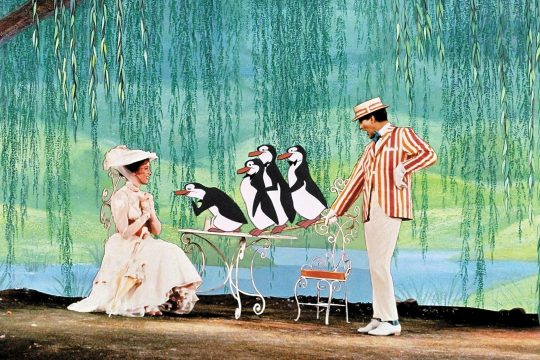
Julie Andrews, Dick Van Dyke and penguins, in ‘Mary Poppins’ (1964).
Generally speaking, and the Mary Poppins sequel aside, more contemporary efforts seek to subvert this feeling of harmony and control, instead embracing the chaos of two worlds colliding, the cartoons there to shock rather than sing. Henry Selick’s frequently nightmarish James and the Giant Peach (1996) leans into this crossover as something uncanny and macabre by combining live action with stop motion, as its young protagonist eats his way into another world, meeting mechanical sharks and man-eating rhinos. Sally Jane Black describes it as “riding the Burton-esque wave of mid-’90s mall goth trends and blending with the differently demonic Dahl story”.
Science-classroom staple Osmosis Jones (2001) finds that within the human body, the internal organs serve as cities full of drawn white-blood-cell cops. The late Stephen Hillenburg’s The Spongebob Squarepants Movie (2004) turns its real-life humans into living cartoons themselves, particularly in a bonkers sequence featuring David Hasselhoff basically turning into a speedboat.
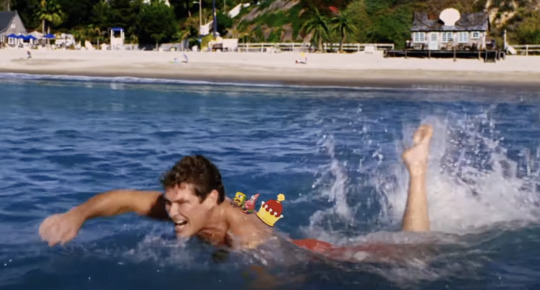
David Hasselhoff picks up speed in ‘The Spongebob Squarepants Movie’ (2004).
The absurdity behind the collision of the drawn and the real is never better embodied than in another of our highest-rated live/animated hybrids. Released in 1988, Robert Zemeckis’ Who Framed Roger Rabbit shows off a deep understanding—narratively and aesthetically—of the material that it’s parodying, seeking out the impeccable craftsmanship of legends such as director of animation Richard Williams (1993’s The Thief and the Cobbler), and his close collaborator Roy Naisbitt. The forced perspectives of Naisbitt’s mind-bending layouts provide much of the rocket fuel driving the film’s madcap cartoon opening.
Distributed by Walt Disney Pictures, Roger Rabbit utilizes the Disney stable of characters as well as the Looney Tunes cast to harken back to America’s golden age of animation. It continues a familiar scenario where the ’toons themselves are autonomous actors (as also seen in Friz Freleng’s 1940 short You Ought to Be in Pictures, in which Daffy Duck convinces Porky Pig to try his acting luck in the big studios).
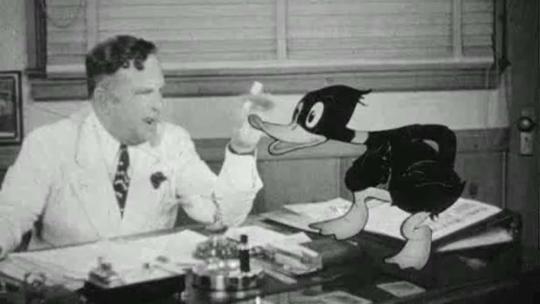
Daffy Duck plots his rise up the acting ranks in ‘You Ought to Be in Pictures’ (1940).
Through this conceit, Zemeckis is able to celebrate the craft of animation, while pastiching both Chinatown, the noir genre, and the mercenary nature of the film industry (“the best part is… they work for peanuts!” a studio exec says of the cast of Fantasia). As Eddie Valiant, Bob Hoskins’ skepticism and disdain towards “toons” is a giant parody of Disney’s more traditional approach to matching humans and drawings.
Adult audiences are catered for with plenty of euphemistic humor and in-jokes about the history of the medium. It’s both hilarious (“they… dropped a piano on him,” one character solemnly notes of his son) and just the beginning of Hollywood toying with feature-length stories in which people co-exist with cartoons, rather than dipping in and out of fantasy sequences. It’s not just about how the cartoons appear on the screen, but how the human world reacts to them, and Zemeckis gets a lot of mileage out of applying ’toon lunacy to our world.
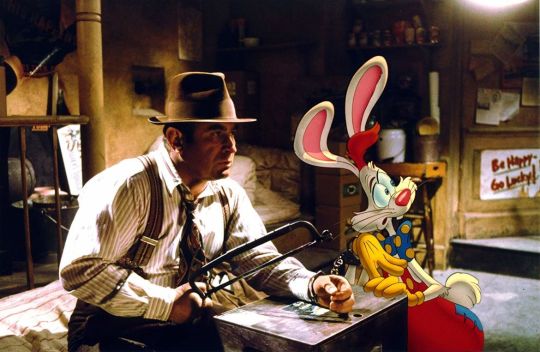
Bob Hoskins in ‘Who Framed Roger Rabbit?’ (1988).
The groundbreaking optical effects and compositing are excellent (and Hoskins’ amazing performance should also be credited for holding all of it together), but what makes Roger Rabbit such a hit is that sense of controlled chaos and a clever tonal weaving of violence and noirish seediness (“I’m not bad… I’m just drawn that way”) through the cartoony feel. And it is simply very, very funny.
It could be said that, with Roger Rabbit, Zemeckis unlocked the formula for how to modernize the live-action and animation hybrid, by leaning into a winking parody of what came before. It worked so perfectly well that it helped kickstart the ‘Disney renaissance' era of animation. Roger Rabbit has influenced every well-known live-action/animation hybrid produced since, proving that there is success and fun to be had by completely upending Mary Poppins-esque quirks. Even Disney’s delightful 2007 rom-com Enchanted makes comedy out of the idea of cartoons crossing that boundary.
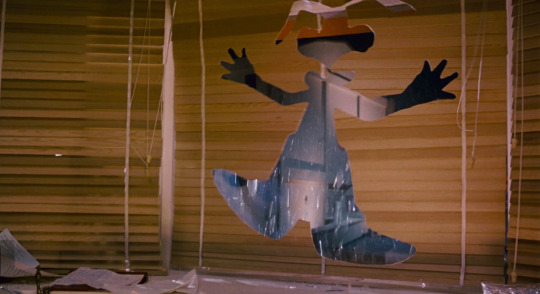
When a cartoon character meets real-world obstacles.
Even when done well, though, hybrids are not an automatic hit. Sitting at a 2.8-star average, Joe Dante’s stealthily great Looney Tunes: Back in Action (2003) is considered by the righteous to be the superior live-action/animated Looney Tunes hybrid, harkening back to the world of Chuck Jones and Frank Tashlin. SilentDawn states that the film deserves the nostalgic reverence reserved for Space Jam: “From gag to gag, set piece to set piece, Back in Action is utterly bonkers in its logic-free plotting and the constant manipulation of busy frames.”
With its Tinseltown parody, Back in Action pulls from the same bag of tricks as Roger Rabbit; here, the Looney Tunes characters are famous, self-entitled actors. Dante cranks the meta comedy up to eleven, opening the film with Matthew Lillard being accosted by Shaggy for his performance in the aforementioned Scooby Doo movie (and early on throwing in backhanded jokes about the practice of films like itself as one character yells, “I was brought in to leverage your synergy!”).
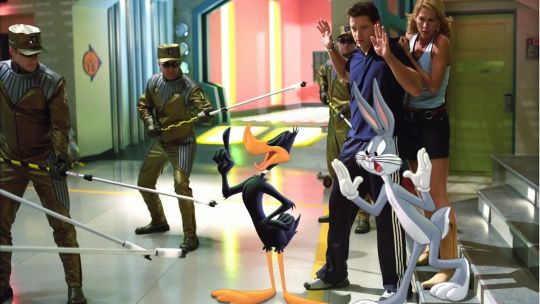
Daffy Duck with more non-stop banter in ‘Looney Tunes: Back in Action’ (2003).
Back in Action is even more technically complex than Roger Rabbit, seamlessly bringing Looney Tunes physics and visual language into the real world. Don’t forget that Dante had been here before, when he had Anthony banish Ethel into a cartoon-populated television show in his segment of Twilight Zone: The Movie. Another key to this seamlessness is star Brendan Fraser, at the height of his powers here as “Brendan Fraser’s stunt double”.
Like Hoskins before him, Fraser brings a wholehearted commitment to playing the fed-up straight man amidst cartoon zaniness. Fraser also brought that dedication to Henry Selick's Monkeybone (2001), a Roger Rabbit-inspired sex comedy that deploys a combo of stop-motion animation and live acting in a premise amusingly close to that of 1992’s Cool World (but more on that cult anomaly shortly). A commercial flop, Back in Action was the last cinematic outing for the Looney Tunes for some time.
Nowadays, when we think of live-action animation, it’s hard not to jump straight to an image of Michael Jordan’s arm stretching to do a half-court dunk to save the Looney Tunes from slavery. There’s not a lot that can be fully rationalized about the 1996 box-office smash, Space Jam. It is a bewildering cartoon advert for Michael Jordan’s baseball career, dreamed up off the back of his basketball retirement, while also mashing together different American icons. Never forget that the soundtrack—one that, according to Benjamin, “makes you have to throw ass”—includes a song with B-Real, Coolio, Method Man and LL Cool J.
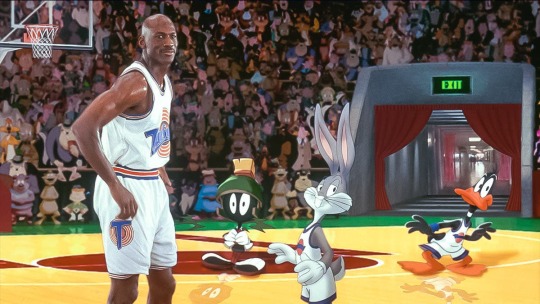
Michael Jordan and teammates in ‘Space Jam’ (1996).
Space Jam is a film inherently born to sell something, predicated on the existing success of a Nike commercial rather than any obvious passion for experimentation. But its pure strangeness, a growing nostalgia for the nineties, and meticulous compositing work from visual-effects supervisor Ed Jones and the film’s animation team (a number of whom also worked on both Roger Rabbit and Back in Action), have all kept it in the cultural memory.
The films is backwards, writes Jesse, in that it wants to distance itself from the very cartoons it leverages: “This really almost feels like a follow-up to Looney Tunes: Back in Action, rather than a predecessor, because it feels like someone watched the later movie, decided these Looney Tunes characters were a problem, and asked someone to make sure they were as secondary as possible.” That attempt to place all the agency in Jordan’s hands was a point of contention for Chuck Jones, the legendary Warner Bros cartoonist. He hated the film, stating that Bugs would never ask for help and would have dealt with the aliens in seven minutes.
Space Jam has its moments, however. Guy proclaims “there is nothing that Deadpool as a character will ever have to offer that isn’t done infinitely better by a good Bugs Bunny bit”. For some, its problems are a bit more straightforward, for others it’s a matter of safety in sport. But the overriding sentiments surrounding the film point to a sort of morbid fascination with the brazenness of its concept.
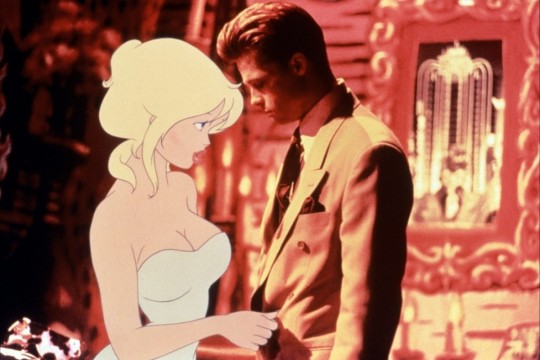
Holli Would (voiced by Kim Basinger) and Frank Harris (Brad Pitt) blur the lines in ‘Cool World’ (1992).
Existing in the same demented… space… as Space Jam, Paramount Pictures bought the idea for Cool World from Ralph Bakshi as it sought to have its own Roger Rabbit. While Brad Pitt described it as “Roger Rabbit on acid” ahead of release, Cool World itself looks like a nightmare version of Toontown. The film was universally panned at the time, caught awkwardly between being far too adult for children but too lacking in any real substance for adults (there’s something of a connective thread between Jessica Rabbit, Lola Bunny and Holli Would).
Ralph Bakshi’s risqué and calamitously horny formal experiment builds on the animator’s fascination with the relationship between the medium and the human body. Of course, he would go from the immensely detailed rotoscoping of Fire and Ice (1983) to clashing hand-drawn characters with real ones, something he had already touched upon in the seventies with Heavy Traffic and Coonskin, whose animated characters were drawn into real locations. But no one besides Bakshi quite knew what to do with the perverse concept of Brad Pitt as a noir detective trying to stop Gabriel Byrne’s cartoonist from having sex with a character that he drew—an animated Kim Basinger.
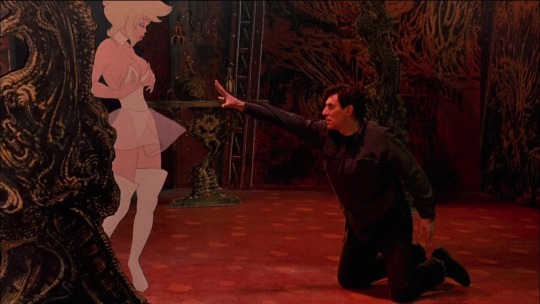
Jack Deebs (Gabriel Byrne) attempts to cross over to Hollie Would in ‘Cool World’ (1992).
Cool World’s awkwardness can be attributed to stilted interactions between Byrne, Pitt and the animated world, as well as studio meddling. Producer Frank Mancuso Jr (who was on the film due to his father running Paramount) demanded that the film be reworked into something PG-rated, against Bakshi’s wishes (he envisioned an R-rated horror), and the script was rewritten in secret. It went badly, so much so that Bakshi eventually punched Mancuso Jr in the face.
While Cool World averages two stars on Letterboxd, there are some enthusiastic holdouts. There are the people impressed by the insanity of it all, those who just love them a horny toon, and then there is Andrew, a five-star Cool World fan: “On the surface, it’s a Lovecraftian horror with Betty Boop as the villain, featuring a more impressive cityscape than Blade Runner and Dick Tracy combined, and multidimensional effects that make In the Mouth of Madness look like trash. The true star, however, proves to be the condensed surplus of unrelated gags clogging the arteries of the screen—in every corner is some of the silliest cel animation that will likely ever be created.”
There are even those who enjoy its “clear response to Who Framed Roger Rabbit”, with David writing that “the film presents a similar concept through the lens of the darkly comic, perverted world of the underground cartoonists”, though also noting that without Bakshi’s original script, the film is “a series of half steps and never really commits like it could”. Cool World feels both completely deranged and strangely low-energy, caught between different ideas as to how best to mix the two mediums. But it did give us a David Bowie jam.
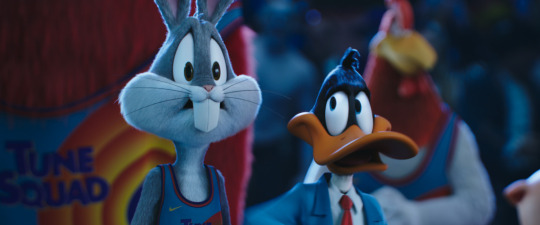
‘Space Jam: A New Legacy’ is in cinemas and on HBO Max now.
Craft is of course important, but generally speaking, maybe nowadays a commitment to silliness and a sincere love for the medium’s history is the thing that makes successful live-action/animation hybrids click. It’s an idea that doesn’t lend itself to being too cool, or even entirely palatable. The trick is to be as fully dotty as Mary Poppins, or steer into the gaucheness of the concept, à la Roger Rabbit and Looney Tunes: Back in Action.
It’s quite a tightrope to walk between good meta-comedy and a parade of references to intellectual property. The winningest strategy is to weave the characters into the tapestry of the plot and let the gags grow from there, rather than hoping their very inclusion is its own reward. Wait, you said what is coming out this week?
Related content
Rootfish Jones’s list of cartoons people are horny for
The 100 Sequences that Shaped Animation: the companion list to the Vulture story
Jose Moreno’s list of every animated film made from 1888 to the present
Follow Kambole on Letterboxd
#kambole campbell#mary poppins#ralph bakshi#hayao miyazaki#ghibli#disney#who framed roger rabbit#roger rabbit#spongebob squarepants#spongebob#animation#live action animation#live action animation hybrid#stop motion animation#stop motion#wes anderson#brad pitt#bob hoskins#genre#space jam#space jam a new legacy#michael jordan#lebron james#looney tunes#bugs bunny#daffy duck#warner bros#2d animation#letterboxd
26 notes
·
View notes